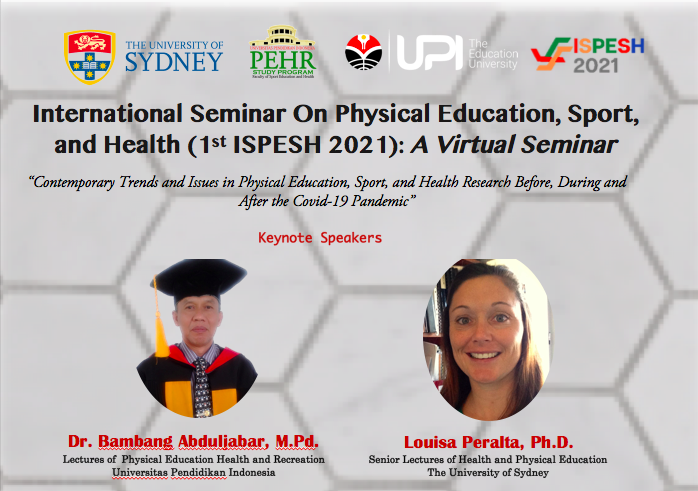KEYNOTE SPEAKERS

ISPESH 2021: December 8th, 2021
Keynote presentation: Peralta
School Based Programs To Enhance Students’ Physical Activity And Cardiorespiratory Fitness Levels
Background: Despite Australia’s reputation as a sporting nation, our children are among the least active in the world (140th of 146 countries1) and are less fit than previous generations2. As physical activity is one of the leading modifiable factors for cardiorespiratory fitness3, it is unsurprising that there has been such a strong decline in children’s cardiorespiratory fitness over the last three decades2. Globally, children’s VO2 Max has decreased by 1?mL/kg/min per decade since the 1980s, with Australia showing a substantially steeper decline of 1.7?mL/kg/min per decade2.
Methods: A recent pooled analysis of individual participant data from controlled trials assessed the impact of school-based physical activity interventions on cardiorespiratory fitness and device-measured physical activity4. Data for 6621 children and adolescents aged 4-18 years were included from a range of countries. Findings showed that interventions modestly improved students’ cardiorespiratory fitness by 0.47 mL/kg/min (95% confidence interval 0.33 to 0.61), but the effects were not distributed equally across subpopulations. Girls and older students benefited less than boys and younger students. Students with lower levels of initial fitness, and those with higher levels of baseline physical activity benefitted more than those who were initially fitter and less active, respectively. Interventions had a modest positive effect on physical activity with approximately one additional minute per day of both moderate and vigorous physical activity. Changes in vigorous, but not moderate intensity, physical activity explained a small amount (~5%) of the intervention effect on cardiorespiratory fitness. Using these recent findings, I will present the most recent school-based programs implemented in Australian schools to combat low physical activity and cardiorespiratory fitness levels and learnings.
Results: Professional Learning to Help Teachers Promote Activity in Youth (iPLAY) is a primary school intervention conducted in NSW, Australia5. Of 1219 participants (49% girls; mean [SD] age, 8.85 [0.71] years) from 22 schools (only collected data from Years 4 and 5 students; aged 7-10 years of ages), 1188 students provided baseline primary outcome data. At 12 months, the number of 20-m shuttle runs increased by 3.32 laps (95%CI, 2.44-4.20 laps) in the intervention schools and 2.11 laps (95%CI, 1.38-2.85 laps) in the control schools (adjusted difference = 1.20 laps; 95%CI, 0.17-2.24 laps). By 24 months, the adjusted difference was 2.22 laps (95%CI, 0.89-3.55laps). Burn 2 Learn (B2L) assessed the impact of the B2L intervention on cardiorespiratory fitness in a sample of senior school students (Years 11 and 12; age 16-18 years) using a cluster randomised controlled trial (RCT)6. A group-by-time effect was found for cardiorespiratory fitness (difference=4.1 laps, 95% CI 1.8 to 6.4) at the primary end-point (6 months), but not at 12 months.
Discussion: iPLAY is the first to show that a school-based intervention can improve children’s cardiorespiratory fitness when delivered across many schools over an extended period. However, school-based physical activity interventions around the world are typically more effective for some groups than others4. This was also true of iPLAY, which was more effective for boys than girls, and younger compared with older students. Implementing high intensity interval training (HIIT) during curricular time improved adolescents’ cardiorespiratory fitness at 6 months. Findings suggest B2L is unlikely to be an effective and sustainable approach for older students, unless teachers embed sessions within the school day.
References:
- Guthold R … Bull FC. Global trends in insufficient physical activity among adolescents: a pooled analysis of 298 population-based surveys with 1·6 million participants. Lancet Child Adolesc Health 2020; 4: 23–35.
- Tomkinson GR … Tremblay MS. Temporal trends in the cardiorespiratory fitness of children and adolescents representing 19 high-income and upper middle-income countries between 1981 and 2014. Br J Sports Med 2019; 53: 478–486.
- Raghuveer G …. Edwards, NM. Cardiorespiratory Fitness in Youth: An Important Marker of Health: A Scientific Statement From the American Heart Association. Circulation 2020; 142.
- Hartwig TB …. del Pozo Cruz, B. School-based interventions modestly increase physical activity and cardiorespiratory fitness but are least effective for youth who need them most: an individual participant pooled analysis of 20 controlled trials. British journal of sports medicine. 2021 Jul 1;55(13):721-9.
- Lonsdale C … Salmon J. Effect of a Scalable School-Based Intervention on Cardiorespiratory Fitness in Children: A Cluster Randomized Clinical Trial. JAMA pediatrics. 2021 May 3.
- Lubans DR…Weaver N. Time-efficient intervention to improve older adolescents’ cardiorespiratory fitness: findings from the ‘Burn 2 Learn’cluster randomised controlled trial. British Journal of Sports Medicine. 2021 Jul 1;55(13):751-8.
UNTUK INFORMASI PELAKSANAAN 2ND ISPESH 2022 DAPAT DILIHAT DI http://ispesh.event.upi.edu/
